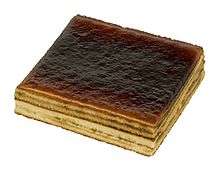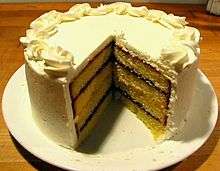Tiramisu
Tiramisu (from the Italian language, spelled tiramisù, [ˌtiramiˈsu], meaning "pick me up" or "cheer me up")[1] is a coffee-flavoured Italian dessert. It is made of ladyfingers (savoiardi) dipped in coffee, layered with a whipped mixture of eggs, sugar and mascarpone cheese, flavoured with cocoa. The recipe has been adapted into many varieties of cakes and other desserts.[2] Its origins are often disputed among Italian regions Veneto and Friuli Venezia Giulia.
 A slice of Tiramisu | |
| Course | Dessert |
|---|---|
| Place of origin | Italy |
| Region or state | Veneto Friuli Venezia Giulia |
| Serving temperature | Cold |
| Main ingredients | Savoiardi, egg yolks, mascarpone, cocoa, coffee |
History
Tiramisu appears to have been invented in the 1960s or 1970s, but beyond that, its origins are unclear.
Recipes named "tiramisu" are unknown in cookbooks before the 1960s. The word appears in print in Italian in 1980,[3] and in English in 1982.[4][5]
Some accounts of the origin of tiramisu date its invention to the 1960s in the region of Veneto, Italy, at the restaurant "Le Beccherie" in Treviso. Specifically, the dish is claimed to have first been created by a confectioner named Roberto Linguanotto, owner of "Le Beccherie".[6][7] Le Beccherie is supposed to have invented it on 24 December 1969.[8][9][10][11] It is sometimes claimed that Tiramisu has aphrodisiac effects and was served in brothels in Treviso.[12] Some debate remains, however.[13]
Other sources report the creation of the cake as originating towards the end of the 17th century in Siena in honour of Grand Duke Cosimo III.[14]
There is also evidence of a "Tiremesù" semi-frozen dessert served by the Vetturino restaurant in Pieris, in the Friuli Venezia Giulia, since 1938.[15] This may be the name's origin, while the recipe for Tiramisu may have originated as a variation of another layered dessert, Zuppa Inglese.[16]
It is mentioned in a 1983 cookbook devoted to cooking of the Veneto.[17]
Tiramisu is similar to other desserts, in particular with the Charlotte, in some versions composed of a Bavarian cream surrounded by a crown of ladyfingers and covered by a sweet cream; the Turin cake (dolce Torino), consisting of ladyfingers soaked in rosolio and alchermes with a spread made of butter, egg yolks, sugar, milk, and dark chocolate; and the Bavarese Lombarda, which is a similar composition of ladyfingers and egg yolks (albeit cooked ones). In Bavarese, butter and rosolio (or alchermes) are also used, but not mascarpone cream nor coffee.
Interest in tiramisu in the United States increased in 1993 when Tom Hanks' protagonist in the comedy Sleepless in Seattle heard of it only as a mysterious thing that modern women loved.[18]
On July 29, 2017, Tiramisu was entered by the Ministry of Agricultural, Food and Forestry Policies on the list of traditional Friulian and Giulian agri-food products in the Friuli Venezia Giulia region.[19][20]
Original characteristics


Traditional tiramisu contains a short list of ingredients: finger biscuits, egg yolks, sugar, coffee, mascarpone cheese, cocoa powder and sometimes liquor.
The original shape of the cake is round, although the shape of the biscuits also allows the use of a rectangular or square pan. However, it is often assembled in round glasses, which show the various layers, or pyramid. Modern versions can have the addition of whipped cream or whipped egg, or both, combined with mascarpone cream. This makes the dish lighter, thick and foamy. Among the most common alcoholic changes includes the addition of Marsala. The cake is usually eaten cold.
Another variation involves the preparation of the cream with eggs heated to sterilize it, but not so much that the eggs scramble. Over time, replacing some of the ingredients, mainly coffee, there arose numerous variants such as tiramisu with chocolate, amaretto, berry, lemon, strawberry, pineapple, yogurt, banana, raspberry, and coconut. These are however not considered true Tiramisu as these variations only share the layered characteristic of Tiramisu; these examples more closely resemble variations of trifle.
Numerous variations of Tiramisu exist. Some cooks use other cakes or sweet, yeasted breads, such as panettone, in place of ladyfingers (savoiardi).[21] Bakers living in different Italian regions often debate the use and structural qualities of utilising other types of cookies, such as pavesini for instance, in the recipe.[22] Other cheese mixtures are used as well, some containing raw eggs, and others containing no eggs at all. Marsala wine can be added to the recipe, but other liquors are frequently substituted for it in both the coffee and the cheese mixture, including dark rum, Madeira, port, brandy, Malibu, or Irish cream and especially coffee-flavoured liqueurs such as Tia Maria and Kahlúa.[23] Disaronno is also often used to enhance the taste of tiramisu.
See also
References
| Wikibooks Cookbook has a recipe/module on |
| Wikimedia Commons has media related to Tiramisu. |
- Wilbur, T. (2006). Top Secret Restaurant Recipes 2. Penguin Publishing Group. p. 234. ISBN 978-1-101-04213-7.
- "Tiramisu Bread Puddings". bhg.com. Meredith Corporation. Retrieved 31 October 2013.
- Il Sabatini Coletti. Dizionario della Lingua Italiana, s.v.
- Oxford English Dictionary, 1997, s.v.
- "Tiramisu". Merriam-Webster's Online Dictionary. Retrieved 11 June 2020.
- "Le Beccherie".
- "What gave the Tiramisu its name?". Ticino Online. Retrieved 1 October 2013.
- Rosengarten, David (October 2006). "The Man Who Invented Tiramisu!". The Rosengarten Report. Walter Pearce, Salt Pig Publishing. pp. 17–19.
- "Piedigrotta: History". Retrieved 14 March 2010.
- Vozzella, Laura (8 October 2006). "The Unsung Inventor of Tiramisu". The Baltimore Sun. Retrieved 21 April 2014.
- Black, Jane (10 July 2007). "The Trail of Tiramisu". The Washington Post. Retrieved 11 July 2007.
- "THE ORIGIN OF TIRAMISÙ: "FACT AND LEGEND". ⋆ Accademia Del Tiramisù".
- Squires, Nick (17 May 2016). "Italian regions battle over who invented tiramisu". Retrieved 27 March 2018 – via www.telegraph.co.uk.
- Soletti, Francesco; Toscani, Ettore (2004). L'Italia del caffè (in Italian). p. 110.
- Dolce Jasmine (2017-11-13), Tiramisù: The story behind it, retrieved 2017-11-14
- "History of tiramisù". Archived from the original on 4 June 2012. Retrieved 16 August 2010.
- Capnist, Giovanni (1983). I Dolci Del Veneto. ISBN 88-7021-239-4.
- Saporito, Jeff (3 November 2015). "What's the meaning of the tiramisu joke in "Sleepless in Seattle"". screenprism.com. Retrieved 12 August 2019.
- "Prodotti Agroalimentari Tradizionali". politicheagricole.it (in Italian). Ministero delle politiche agricole alimentari e forestali.
- "GU Serie Generale n.176" (in Italian). 29 July 2017.
- Larousse Gastronomique, New York: Clarkson Potter Publishers, 2001, pp. 1214.
- "Tiramisù: pavesini vs savoiardi, chi vince?". Agrodolce. Archived from the original on 2018-09-29. Retrieved 2020-05-14.
- Cloake, Felicity (2014-03-13). "How to make the perfect tiramisu". The Guardian. ISSN 0261-3077. Retrieved 2019-08-06.
